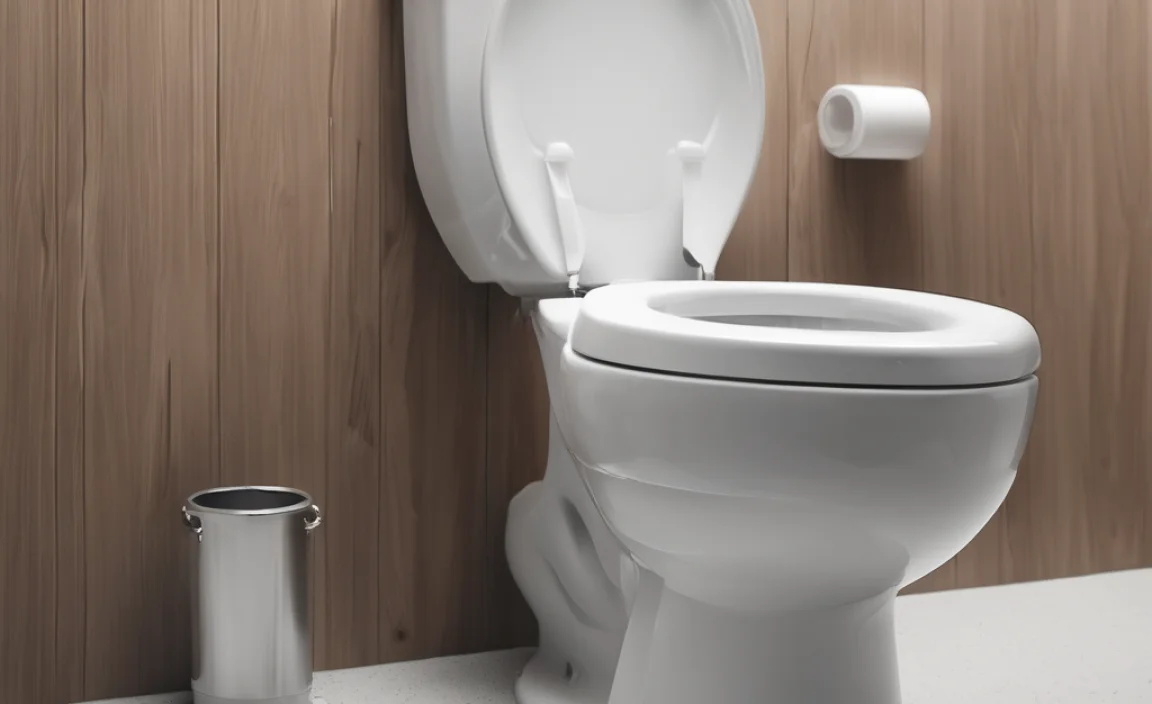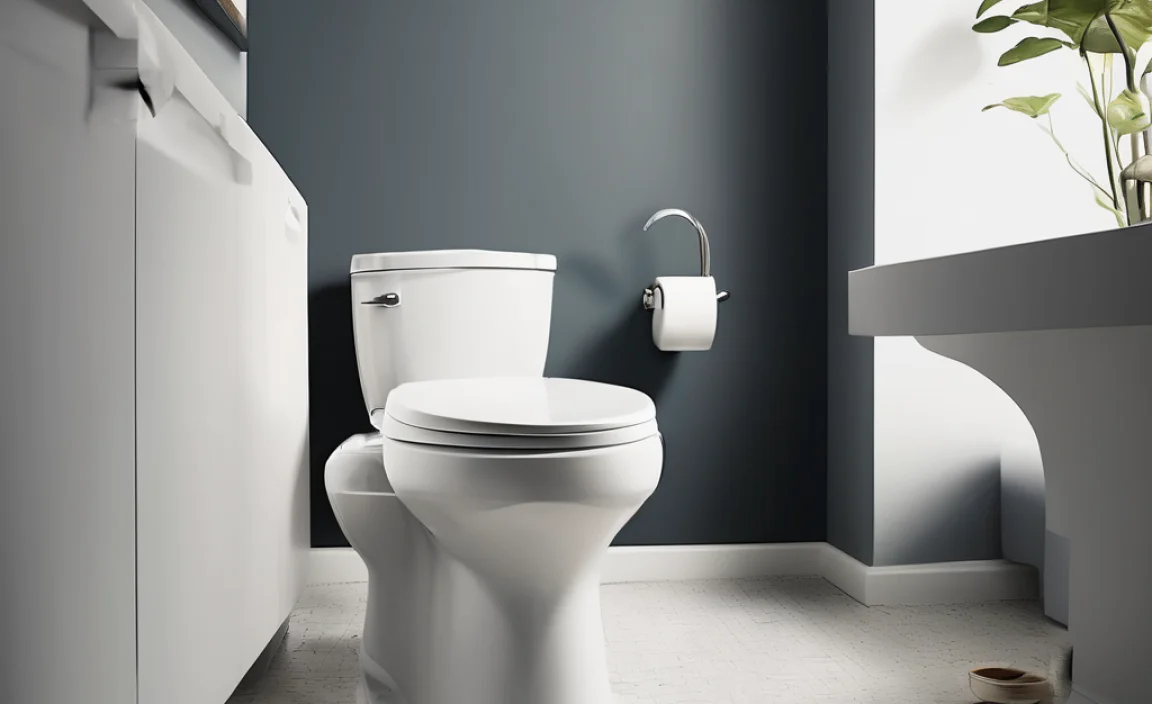**Quick Summary:** Toilet drop-ins offer a convenient way to clean and freshen your toilet bowl, but they’re not always the best choice. While some are safe, others can damage your toilet’s parts, especially if you have a septic system. Always check the ingredients and your toilet’s manual before using them. Think about safer alternatives like toilet bowl cleaners or DIY solutions for a healthier, longer-lasting toilet.
Got a busy life and want a simple way to keep your toilet clean? Toilet drop-ins seem like the perfect solution. Just toss one in the tank, and you’re good to go, right? Well, not always. While they’re super easy to use, some can cause problems down the road. We’re talking about potential damage to your toilet’s inner workings and even your septic system.
In this guide, we’ll explore whether toilet drop-ins are a good idea. We’ll cover the pros and cons, what to watch out for, and some safer ways to keep your toilet sparkling. Let’s dive in and keep your bathroom fresh without the worry!
What are Toilet Drop-Ins?

Toilet drop-ins, also known as toilet bowl cleaner tablets or toilet tank tablets, are chemical cleaning agents designed to be placed directly into your toilet tank. They slowly dissolve over time, releasing cleaning and disinfecting agents into the bowl with each flush. The main purpose? To keep your toilet bowl clean, reduce stains, and provide a fresh scent with minimal effort.
Types of Toilet Drop-Ins
You’ll find a few different types of toilet drop-ins on the market, each with slightly different ingredients and purposes:
- Bleach Tablets: These contain chlorine bleach, which is a powerful disinfectant and stain remover. They’re effective at killing bacteria and removing tough stains, but they can also be harsh on your toilet’s components and the environment.
- Non-Bleach Tablets: These use alternative chemicals like hydrogen peroxide or sodium percarbonate to clean and disinfect. They’re generally considered safer for your toilet and septic system than bleach tablets.
- Enzyme Tablets: These contain enzymes that break down organic waste, helping to prevent clogs and odors. They’re often marketed as being septic-safe.
- Scented Tablets: These are designed to primarily freshen the toilet bowl with each flush, often containing fragrances to leave a pleasant smell.
Common Ingredients to Watch Out For
It’s important to know what’s in those tablets you’re dropping into your toilet tank. Here are some common ingredients and why you should be aware of them:
- Chlorine Bleach (Sodium Hypochlorite): Effective at cleaning but can corrode rubber and plastic parts in your toilet.
- 2-Bromo-2-Nitropropane-1,3-Diol (Bronopol): An antimicrobial agent that can release formaldehyde, a known carcinogen.
- Sodium Dichloroisocyanurate: Another chlorine-releasing compound that can be harsh on toilet components and may cause irritation.
- Surfactants: Help to loosen dirt and grime, but some can be harmful to aquatic life if they end up in wastewater.
- Fragrances: Can cause allergic reactions in some people and may contain volatile organic compounds (VOCs).
The Potential Problems with Toilet Drop-Ins

While toilet drop-ins offer convenience, they can also cause a range of issues. Understanding these potential problems can help you make an informed decision about whether or not to use them.
Damage to Toilet Components
The chemicals in toilet drop-ins, especially those containing bleach, can corrode and degrade the rubber and plastic parts inside your toilet tank. This includes:
- Flapper: The rubber flapper that seals the flush valve can become brittle and warped, leading to leaks and a constantly running toilet.
- Fill Valve: The fill valve, which controls the water entering the tank, can become clogged or damaged by the chemicals, causing it to malfunction.
- Flush Valve: The flush valve assembly can also be affected, leading to poor flushing performance.
Replacing these parts can be costly and time-consuming. Over time, the continuous exposure to harsh chemicals can significantly shorten the lifespan of your toilet’s components.
Impact on Septic Systems
If you have a septic system, you need to be extra careful about what you put down your toilet. Septic systems rely on beneficial bacteria to break down waste. Harsh chemicals from toilet drop-ins can kill these bacteria, disrupting the natural balance of your septic tank. This can lead to:
- Reduced Efficiency: The septic system becomes less effective at breaking down waste, leading to backups and clogs.
- System Failure: In severe cases, the septic system can fail completely, requiring costly repairs or replacement.
- Environmental Contamination: Untreated wastewater can leach into the surrounding soil, contaminating groundwater.
Enzyme-based drop-ins are often marketed as septic-safe, but it’s still wise to use them sparingly and monitor your system closely.
Water Quality Concerns
The chemicals released by toilet drop-ins eventually end up in the wastewater system. While wastewater treatment plants remove many contaminants, some chemicals can persist and affect water quality. This can be a concern for:
- Drinking Water: Some chemicals may not be completely removed during water treatment, potentially ending up in your drinking water supply.
- Aquatic Ecosystems: Chemicals released into waterways can harm aquatic life and disrupt ecosystems.
- Well Water: If you have a private well, there’s a risk of contamination if your septic system isn’t functioning properly due to the use of harsh chemicals.
Potential for Skin and Eye Irritation
Direct contact with toilet drop-ins or the water in the toilet tank can cause skin and eye irritation, especially for those with sensitive skin or allergies. It’s important to:
- Avoid Direct Contact: Wear gloves when handling toilet drop-ins or cleaning the toilet tank.
- Wash Hands Thoroughly: Always wash your hands after handling toilet drop-ins or touching the inside of the toilet tank.
- Keep Out of Reach of Children and Pets: Store toilet drop-ins in a secure location where children and pets cannot access them.
| Problem | Description | Potential Consequences |
|---|---|---|
| Damage to Toilet Components | Chemicals corrode rubber and plastic parts. | Leaks, running toilet, costly repairs. |
| Impact on Septic Systems | Kills beneficial bacteria in septic tank. | Reduced efficiency, system failure, environmental contamination. |
| Water Quality Concerns | Chemicals persist in wastewater. | Contamination of drinking water, harm to aquatic ecosystems. |
| Skin and Eye Irritation | Direct contact with chemicals. | Irritation, allergic reactions. |
When Toilet Drop-Ins Might Be Okay to Use

Despite the potential problems, there are situations where toilet drop-ins might be an acceptable option. It largely depends on the type of drop-in, your plumbing system, and how carefully you use them.
If You Don’t Have a Septic System
If your home is connected to a municipal sewer system, the impact on wastewater treatment is less direct than with a septic system. Wastewater treatment plants are designed to handle a variety of chemicals, so the occasional use of toilet drop-ins is less likely to cause significant problems. However, it’s still wise to use them sparingly and choose less harmful options.
Using Septic-Safe Options
Some toilet drop-ins are specifically marketed as “septic-safe.” These usually contain enzymes that help break down waste without harming the beneficial bacteria in your septic tank. While they may be a better option than bleach-based tablets, it’s still a good idea to:
- Read the Label Carefully: Make sure the product is truly septic-safe and doesn’t contain harsh chemicals.
- Use Sparingly: Even septic-safe products can disrupt the balance of your system if used excessively.
- Monitor Your System: Watch for signs of problems like slow drains or foul odors.
For Infrequent Cleaning Boosts
If you primarily use other cleaning methods but want an occasional boost for stain removal or freshening, toilet drop-ins can be used sparingly. For example, you might use a bleach-based tablet once a month to tackle stubborn stains, then rely on milder methods the rest of the time. This can help minimize the potential for damage.
When Following Directions Carefully
Always follow the manufacturer’s instructions when using toilet drop-ins. This includes:
- Using the Correct Amount: Don’t use more tablets than recommended.
- Replacing at the Recommended Interval: Avoid letting the tablet completely dissolve, as this can release a concentrated dose of chemicals.
- Proper Storage: Store unused tablets in a cool, dry place out of reach of children and pets.
Safer Alternatives for Cleaning Your Toilet
If you’re concerned about the potential problems with toilet drop-ins, there are plenty of safer and more environmentally friendly ways to keep your toilet clean and fresh.
Regular Toilet Bowl Cleaner
Using a standard toilet bowl cleaner and a toilet brush is a simple and effective way to maintain a clean toilet. Look for cleaners that are:
- Non-Toxic: Choose cleaners that are free of harsh chemicals like bleach, ammonia, and phosphates.
- Biodegradable: Opt for cleaners that break down easily in the environment.
- Scented with Essential Oils: Many natural cleaners use essential oils for fragrance, which are less likely to cause irritation than synthetic fragrances.
Simply apply the cleaner under the rim of the bowl, let it sit for a few minutes, scrub with a toilet brush, and flush.
DIY Cleaning Solutions
You can make your own effective toilet cleaning solutions using common household ingredients. Here are a few ideas:
- Baking Soda and Vinegar: Pour one cup of baking soda into the toilet bowl, followed by two cups of vinegar. Let it fizz for about 30 minutes, then scrub and flush.
- Borax: Sprinkle half a cup of borax into the toilet bowl, let it sit for a few hours or overnight, then scrub and flush.
- Lemon Juice: Pour one cup of lemon juice into the toilet bowl, let it sit for a few hours, then scrub and flush. The citric acid in lemon juice helps to break down stains and freshen the bowl.
Toilet Bowl Cleaning Gels
These gels attach to the inside of the toilet bowl and release cleaning agents with each flush. They’re often less harsh than drop-in tablets because they don’t sit in the tank and continuously expose the components to chemicals. Look for gels that are:
- Non-Bleach: Choose gels that use alternative cleaning agents like hydrogen peroxide.
- Septic-Safe: Opt for gels that are specifically designed for use with septic systems.
- Easy to Apply: Choose gels that come with an applicator for easy and mess-free installation.
Toilet Cleaning Wands
These disposable cleaning heads attach to a wand, allowing you to scrub the toilet bowl without having to touch it directly. The cleaning heads are pre-loaded with cleaner, making them convenient and hygienic. Look for wands with:
- Biodegradable Heads: Choose wands with cleaning heads that are made from biodegradable materials.
- Non-Toxic Cleaner: Opt for wands with cleaning heads that are pre-loaded with non-toxic cleaner.
- Easy-to-Use Design: Choose wands that are comfortable to hold and easy to maneuver.
The Benefits of Switching to Safer Alternatives
Switching to safer toilet cleaning alternatives offers several benefits:
- Protecting Your Toilet: Milder cleaning agents won’t corrode or damage your toilet’s components.
- Safeguarding Your Septic System: Septic-safe alternatives won’t disrupt the balance of your septic tank.
- Improving Water Quality: Environmentally friendly cleaners won’t pollute waterways or contaminate drinking water.
- Reducing Irritation: Non-toxic cleaners are less likely to cause skin or eye irritation.
| Alternative | Description | Benefits |
|---|---|---|
| Regular Toilet Bowl Cleaner | Apply cleaner, scrub, and flush. | Effective, easy to use, can be non-toxic. |
| DIY Cleaning Solutions | Use baking soda, vinegar, or lemon juice. | Natural, inexpensive, environmentally friendly. |
| Toilet Bowl Cleaning Gels | Attach gel to bowl, releases cleaner with each flush. | Convenient, less harsh than drop-ins, can be septic-safe. |
| Toilet Cleaning Wands | Disposable cleaning heads attach to a wand. | Hygienic, convenient, can be biodegradable. |
Step-by-Step Guide: Cleaning Your Toilet Without Drop-Ins
Ready to ditch the drop-ins? Here’s a simple guide to keeping your toilet clean using safer methods.
Step 1: Gather Your Supplies
You’ll need:
- Toilet bowl cleaner (non-toxic and biodegradable)
- Toilet brush
- Gloves
- Optional: Baking soda, vinegar, or lemon juice for DIY cleaning
- Optional: Toilet cleaning wand
Step 2: Apply Cleaner
If using a commercial toilet bowl cleaner:
- Put on gloves.
- Lift the toilet seat and apply the cleaner under the rim of the bowl, coating the entire surface.
- Let it sit for the recommended time (usually 5-10 minutes).
If using a DIY solution (baking soda and vinegar):
- Put on gloves.
- Pour one cup of baking soda into the toilet bowl.
- Slowly pour two cups of vinegar over the baking soda.
- Let it fizz for about 30 minutes.
Step 3: Scrub the Bowl
Using the toilet brush, scrub the entire bowl, paying special attention to stains and areas under the rim. Apply some elbow grease to remove any stubborn buildup.
Step 4: Flush
Flush the toilet to rinse away the cleaner and any loosened debris. If necessary, repeat the cleaning process for particularly dirty areas.
Step 5: Clean the Exterior
Don’t forget to clean the outside of the toilet! Use a disinfectant wipe or a damp cloth with a mild cleaner to wipe down the seat, lid, tank, and base of the toilet.
Step 6: Regular Maintenance
To keep your toilet clean and fresh, aim to clean it at least once a week. Regular cleaning prevents buildup and makes the job easier.
FAQ About Toilet Drop-Ins
Are toilet drop-ins safe for all toilets?
Not always. Toilets with older or fragile parts may be damaged by the chemicals in some drop-ins. Always check your toilet’s manual first.
Will toilet drop-ins harm my septic system?
Some will. Bleach-based drop-ins can kill beneficial bacteria in your septic tank. Look for septic-safe options or consider alternatives.
Can toilet drop-ins stain my toilet bowl?
Yes, some drop-ins can cause staining, especially if they contain dyes or harsh chemicals. Regular cleaning can help prevent this.
Are there any natural alternatives to toilet drop-ins?
Absolutely! Baking soda and vinegar, lemon juice, and borax are all effective and natural toilet cleaning options.
How often should I clean my toilet?
Aim to clean your toilet at least once a week to prevent buildup and maintain a fresh, clean bathroom.
Can I make my own toilet cleaning tablets?
Yes, you can! Recipes often include baking soda, citric acid, and essential oils. Just be sure to store them safely out of reach of children and pets.
What should I do if my toilet drop-in discolors the water?
If the drop-in discolors the water, remove it immediately. Flush the toilet several times to clear the colored water, and consider switching to a different type of cleaner.
Conclusion
So, are toilet drop-ins bad? The answer is: it depends. While they offer convenience, they also come with potential risks to your toilet, septic system, and even the environment. By understanding these risks and exploring safer alternatives, you can make an informed choice that keeps your bathroom clean and your plumbing healthy. Whether you opt for regular cleaning with a non-toxic cleaner, whip up a DIY solution, or choose a septic-safe gel, you can achieve a sparkling toilet without the worry.
Take the time to find a cleaning routine that works for you and your home. With a little effort and the right approach, you can enjoy a fresh, clean bathroom without compromising the health of your plumbing or the environment. Happy cleaning!



